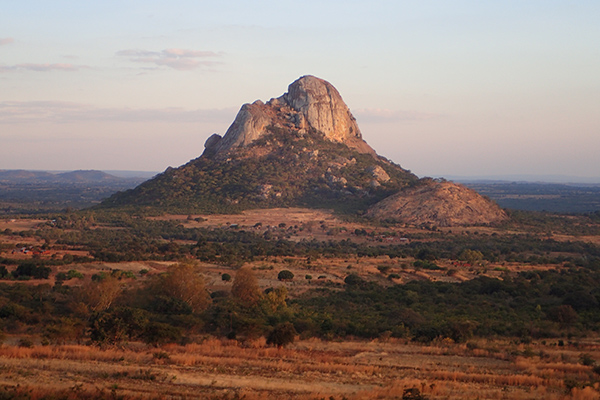
The first large-scale study of ancient human DNA from sub-Saharan Africa opens a long-awaited window into the identity of prehistoric populations in the region and how they moved around and replaced one another over the past 8,000 years.
The findings, published Sept. 21 in Cell by an international research team led by Harvard Medical School, answer several longstanding mysteries and uncover surprising details about sub-Saharan African ancestry—including genetic adaptations for a hunter-gatherer lifestyle and the first glimpses of population distribution before farmers and animal herders swept across the continent about 3,000 years ago.
“The last few thousand years were an incredibly rich and formative period that is key to understanding how populations in Africa got to where they are today,” said David Reich, professor of genetics at HMS and a senior associate member of the Broad Institute of MIT and Harvard. “Ancestry during this time period is such an unexplored landscape that everything we learned was new.”
Reich shares senior authorship of the study with Ron Pinhasi of the University of Vienna and Johannes Krause of the Max Planck Institute for the Science of Human History and the University of Tübingen in Germany.
“Ancient DNA is the only tool we have for characterizing past genomic diversity. It teaches us things we don’t know about history from archaeology and linguistics and can help us better understand present-day populations,” said Pontus Skoglund, a postdoctoral researcher in the Reich lab and the study’s first author. “We need to ensure we use it for the benefit of all populations around the world, perhaps especially Africa, which contains the greatest human genetic diversity in the world but has been underserved by the genomics community.”
Long time coming
Although ancient-DNA research has revealed insights into the population histories of many areas of the world, delving into the deep ancestry of African groups wasn’t possible until recently because genetic material degrades too rapidly in warm, humid climates.
Technological advances—including the discovery by Pinhasi and colleagues that DNA persists longer in small, dense ear bones—are now beginning to break the climate barrier. Last year, Reich and colleagues used the new techniques to generate the first genome-wide data from the earliest farmers in the Near East, who lived between 8,000 and 12,000 years ago.
In the new study, Skoglund and team, including colleagues from South Africa, Malawi, Tanzania and Kenya, coaxed DNA from the remains of 15 ancient sub-Saharan Africans. The individuals came from a variety of geographic regions and ranged in age from about 500 to 8,500 years old.
The researchers compared these ancient genomes—along with the only other known ancient genome from the region, previously published in 2015—against those of nearly 600 present-day people from 59 African populations and 300 people from 142 non-African groups.
With each analysis, revelations rolled in.
“We are peeling back the first layers of the agricultural transition south of the Sahara,” said Skoglund. “Already we can see that there was a whole different landscape of populations just 2,000 or 3,000 years ago.”
Genomic time-lapse
Almost half of the team’s samples came from Malawi, providing a series of genomic snapshots from the same location across thousands of years.
The time-series divulged the existence of an ancient hunter-gatherer population the researchers hadn’t expected.
When agriculture spread in Europe and East Asia, farmers and animal herders expanded into new areas and mixed with the hunter-gatherers who lived there. Present-day populations thus inherited DNA from both groups.
The new study found evidence for similar movement and mixing in other parts of Africa, but after farmers reached Malawi, hunter-gatherers seem to have disappeared without contributing any detectable ancestry to the people who live there today.
“It looks like there was a complete population replacement,” said Reich. “We haven’t seen clear evidence for an event like this anywhere else.”
The Malawi snapshots also helped identify a population that spanned from the southern tip of Africa all the way to the equator about 1,400 years ago before fading away. That mysterious group shared ancestry with today’s Khoe-San people in southern Africa and left a few DNA traces in people from a group of islands thousands of miles away, off the coast of Tanzania.
“It’s amazing to see these populations in the DNA that don’t exist anymore,” said Reich. “It’s clear that gathering additional DNA samples will teach us much more.”
“The Khoe-San are such a genetically distinctive people, it was a surprise to find a closely related ancestor so far north just a couple of thousand years ago,” Reich added.
The new study also found that West Africans can trace their lineage back to a human ancestor that may have split off from other African populations even earlier than the Khoe-San.
Missing links
The research similarly shed light on the origins of another unique group, the Hadza people of East Africa.
“They have a distinct appearance, language and genetics, and some people speculated that, like the Khoe-San, they might represent a very early diverging group from other African populations,” said Reich. “Our study shows that instead, they’re somehow in the middle of everything.”
The Hadza, according to genomic comparisons, are today more closely related to non-Africans than to other Africans. The researchers hypothesize that the Hadza are direct descendants of the group that migrated out of Africa, and possibly spread within Africa as well, after about 50,000 years ago.
Another discovery lay in wait in East Africa.
Scientists had predicted the existence of an ancient population based on the observation that present-day people in southern Africa share ancestry with people in the Near East. The 3,000-year-old remains of a young girl in Tanzania provided the missing evidence.
Reich and colleagues suspect that the girl belonged to a herding population that contributed significant ancestry to present-day people from Ethiopia and Somalia down to South Africa. The ancient population was about one-third Eurasian, and the researchers were able to further pinpoint that ancestry to the Levant region.
“With this sample in hand, we can now say more about who these people were,” said Skoglund.
The finding put one mystery to rest while raising another: Present-day people in the Horn of Africa have additional Near Eastern ancestry that can’t be explained by the group to which the young girl belonged.
Natural selection
Finally, the study took a first step in using ancient DNA to understand genetic adaptation in African populations.
It required “squeezing water out of a stone” because the researchers were working with so few ancient samples, said Reich, but Skoglund was able to identify two regions of the genome that appear to have undergone natural selection in southern Africans.
One adaptation increased protection from ultraviolet radiation, which the researchers propose could be related to life in the Kalahari Desert. The other variant was located on genes related to taste buds, which the researchers point out can help people detect poisons in plants.
The researchers hope that their study encourages more investigation into the diverse genetic landscape of human populations in Africa, both past and present. Reich also said he hopes the work reminds people that African history didn’t end 50,000 years ago when groups of humans began migrating into the Near East and beyond.
“The late Stone Age in Africa is like a black hole, research-wise,” said Reich. “Ancient DNA can address that gap.”
Funding for this research was provided by the National Institutes of Health (grant GM100233), the National Science Foundation (HOMINID BCS-1032255 and BCS-1613577), the DFG/German Research Foundation (KR 4015/1-1), the Max Planck Society, the National Research Foundation of South Africa, the South African Medical Research Council, European Research Council starting grants SEALINKS (206148) and ADNABIOARC (263441), a Wellcome Trust Senior Investigator Award (100719/Z/12/Z), the Wenner-Gren Foundation and the Swedish Research Council (VR grant 2014-453). Reich is a Howard Hughes Medical Institute investigator.
There were a total of 44 study authors from institutions in 11 countries.





